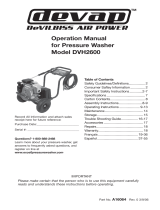
5
DANGER: RISK TO BREATHING (ASPHYXIATION)
WHAT CAN HAPPEN HOW TO PREVENT IT
• Breathing ex haust fumes will cause
se ri ous injury or death! En gine
exhaust contains carbon mon ox ide,
an odorless and deadly gas.
• Operate pressure washer in a well-
ventilated area. Avoid en closed areas
such as ga rages, base ments, etc.
• Never op er ate unit in or near a lo ca tion
occupied by humans or animals.
• Never connect pressure washer to a
TYPE B gas vent.
• Some clean ing fluids con tain
substanc es which could cause injury
to skin, eyes or lungs.
• Use only clean ing fluids spe cif i cally rec-
om mend ed for high pressure washers.
Fol low manufacturers recommendations.
Do not use chlorine bleach or any other
corrosive compound.
DANGER: RISK OF FLUID INJECTION AND LACERATION
WHAT CAN HAPPEN HOW TO PREVENT IT
• Your pressure washer operates at fluid
pressures and velocities high enough
to penetrate human and animal flesh
which could result in amputation or
other serious injury. Leaks caused
by loose fittings or worn or damaged
hoses can result in injection injuries.
DO NOT TREAT FLUID INJECTION
AS A SIMPLE CUT! See a physician
immediately!
• Inspect the high pressure hose regularly.
Replace the hose immediately if it is
damaged, worn, has melted from
contacting the engine, or shows any signs
of cracks, bubbles, pinholes, or other
leakage. Never grasp a high pressure
hose that is leaking or damaged.
• Never touch, grasp or attempt to cover a
pinhole or similar water leak on the high
pressure hose. The stream of water IS
under high pressure and WILL penetrate
skin.
• Never place hands in front of noz zle.
• Direct spray away from self and others.
• Make sure hose and fit tings are tightened
and in good condition. Never hold onto
the hose or fittings during op er a tion.
• Do not allow hose to contact muf fler.
• Never attach or remove wand or hose
fittings while sys tem is pres sur ized.
• When using replacement lances or guns
with this pressure washer, DO NOT use
a lance and/or lance/gun combination
that is shorter in length than what was
provided with this pressure washer as
measured from the nozzle end of the
lance to the gun trigger.
• Use only accessories rated equal to or
higher than the rating of the pressure
washer.




















